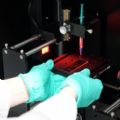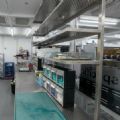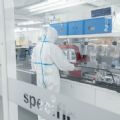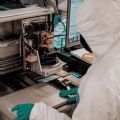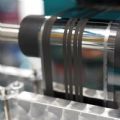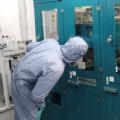- Cleanroom dedicated to manufacturing, characterization and processing of solar cells devices with focused on solution processed OPV and perovskites devices.
- lifetime analysis for in-situ testing of materials and devices
The cleanroom was funded through the Welsh Government Strategic Equipment Grant. These cleanroom facilities have created a unique focal point for PV research in Swansea, and has enabled an enhanced reputation for the printing, coating and testing of PV. It is regularly accessed by over 50 researchers in 7 distinct but related research groups.
It offers state-of-the-art fabrication and characterisation equipment for the printing and testing of solar cells devices with focused on solution processed OPV and perovskites devices. The cleanroom is a humidity and atmospheric controlled environment facility which contains an area a class 1000, and a class 10,000 area. The cleanroom facilities houses all the equipment required for making devices solar cells: 3 Gloveboxes , top-bench coater (i.e. Slot-die coater), screen printers, slot-die R2R coater, NIR drying ovens, and other basic solar cell building infrastructure (spin-coater, hotplates, etc…).
Industrially relevant printing and coating equipment designed and acquired with 3rd generation photovoltaic material in mind are housed in the cleanroom and include slot-die, inkjet, screen printing, blade, bar, flexographic and gravure deposition.
In addition, it has a suite of state-of-the-art device and material characterisation equipment includes FEGSEM, XPS, XRD, FTIR, Raman, SKP-AFM, UV-Vis and Emission Spectroscopy, Phosphorescence Spectroscopy, Fluorescence Microscopy, ns-transient absorption spectroscopy (TAS) and TRPL. Materials can be tested using independent or hyphenated thermal analysis STA-FTIR-GCMS) as well as their Nano mechanical behaviour through tribo-indentation. The project team members will have free access to all characterization facilities owned and operated by SPECIFIC, Swansea University.
Facilities for the complete fabrication and characterization of solar cells, including Oriel Sol Class AAA solar simulators, quantum efficiency (QE) apparatus, electrochemical impedance spectroscopy (EIS), cyclic voltammetry and optoelectronic transient and charge extraction measurements can be performed.
The extensive facilities for lifetime analysis include bespoke capabilities for in-situ testing of materials and devices with the ability to independently vary oxygen, humidity, light and temperature whilst applying any necessary bias.
Module testing can be undertake using a range of cyclic humidity cabinets an Atlas weatherometers, and via QUVA/B, Xenon arc.
A capability also exists for external weathering as part of our PV analysis setup which is integrated into their active buildings. The stability testing equipment has unlocked a new research stream, the testing of device lifetime using international standards. This is a capability only held by a small number of research institutions active in the field.
Services currently offered by the infrastructure
This facility allows the use of relevant printing and coating equipment for perovskite devices and the manufacturing of modules up to 30x30 cm.
These new facilities now allow us the opportunity host researchers from external institutions and in the last 2 years these have included MIT, Oxford University, Bath University, Warwick University, IISER Pune, CINVESTAV Mexico, Universitat Jaume I Spain, Trinity College Dublin and the Catalan Institute of Nanoscience and Nanotechnology (ICN2-CSIC), Barcelona amongst many others.
This is a capability only held by a small number of research institutions active in the field. Furthermore, the advanced capabilities have led to the research group receiving invitations to join large pan-European projects as test partners (CHEETAH, COST ACTION, MAESTRO ITN project)
The key outputs which will have a significant and tangible future impact are the creation of new research streams. In particular, the areas of printed photovoltaics and in the area of stability testing of those PV devices.
Since the development of the facilities over 50 papers have been published with several of those in high impact factor journals in some areas such as, slot-die coating of perovskite solar cells, fully printable mesoscopic perovskite solar cell, use of integrated metallic grids to improve carbon electrode conductivity, consensus statement for stability assessment and reporting for perovskite photovoltaics based on ISOS procedures.
To access under VIPELAB project
- The cleanroom facilities operate on a Monday to Friday basis from 9am until 5pm.
- The access to the facility will be free to all project partners and a senior researcher and a technician from the group will be providing technical support to the users.
support offered
All preparatory work will be also covered by the use of all facilities as well as all the testing and post characterisation. The support by technicians, scientists, power, consumables, solvents, substrates and standard materials are covered as part of the access cost
Partecipation in others relevant Research Projects or activities connected to VIPERLAB
Contact the infrastructure
Expertise



